This Duesenberg is Even More Hideous in Person
Posted on Jun 5, 2022 in Editorials | 2 comments
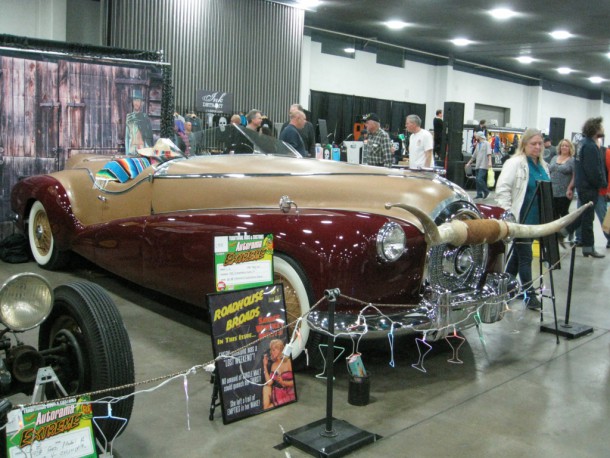
The high-dollar-custom Ridler Award at the Detroit Autorama gets a lot of worthy attention, but real salt of the earth Detroit car culture can be found in Cobo Hall’s basement, The promoters bill the area as Autorama Extreme, and I always make it a point to check out the cars and people downstairs. There’s usually something worthwhile down there like “the first Mustang,” a bassackwards, mid-engine Ford F-1 pickup, or even an Allison V12-powered ’39 Chevy.
This year, walking past the bandstand where a local rockabilly band was doing a Jerry Lee Lewis song, I spotted something around a corner and immediately recognized it as a Duesenberg I’d written about before here at TTAC. It’s a distinctive car. For aesthetic reasons, I doubt anyone would make a replica. So even before I got near enough to see the longhorns up front and the tailfin that looks more like a hunchback’s deformity in back, I knew it was the so-called Tom Mix Duesenberg — a real Doozy in more ways than one.

What would a genuine Duesenberg Model J be doing at the Autorama Extreme with the rat rods, minibikes, and half finished project cars? It actually fits in with all the misfits. In the late 1940s, whoever owned the car removed what was by then a very old fashioned Beverly Berline body by Murphy and replaced it with a custom dual cowl thing-fish that mashed up Cadillac and Oldsmobile body panels. I’m not sure how the rear passengers were supposed to get in; there are no doors or steps to the rear compartment.
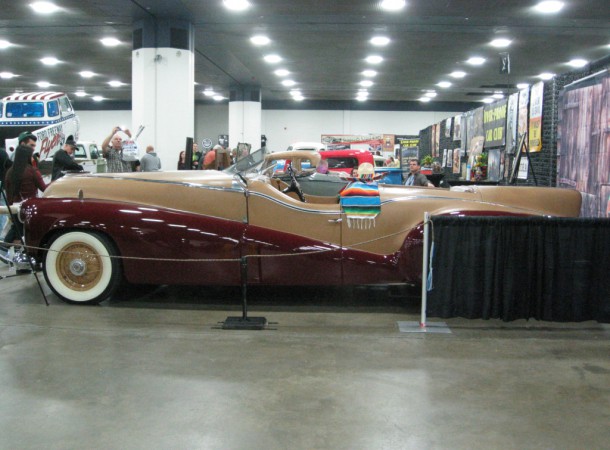
If you squint really hard, particularly looking at the car in profile, you can get a glimpse of the reach that the designer and fabricators failed to grasp. I suppose the owner thought the results looked sporting and contemporary — there’s a Jaguar XK120/Cisitalia 202 fender line. Both of those highly influential cars were introduced in 1948, the year the Duesenberg was rebodied. While I’m sure the goal was something modern, the owner (I presume it was a he, most women have better taste) added a classic touch. The two tone color scheme was effected by covering the upper body panels with beige leather, something cars from the 1920s and earlier might have featured. The proportions aren’t bad, but the devil is all in the details, including those horns, which are, like a cat’s whiskers, wider than the body.
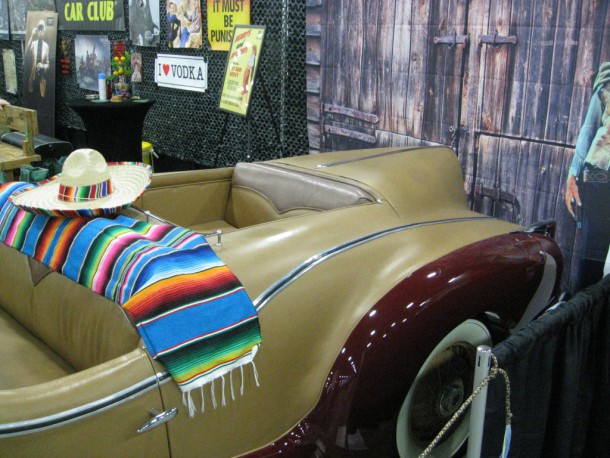
One thing that I’ve learned since I started working with stereo photography (3D) is that things don’t look quite the same in person or three dimensions as they do in mono photography. I always reserve final judgment on a car’s styling until I see it in person. This car is even more hideous in person than it is in photos. Besides depth (it’s nice to know if the tiger is on your side of the river), stereo vision also gives us our sense of shape. Looking at the car in person makes me think that maybe what I’ve been describing as a tailfin was possibly an attempt at creating a boattail rear end. My sense of shape tells me that attempt failed.
As I mentioned, you can almost get an idea of what the designer was going for. Perhaps in the hands of a more talented stylist it could have been magnificent. Instead it’s an oddity.
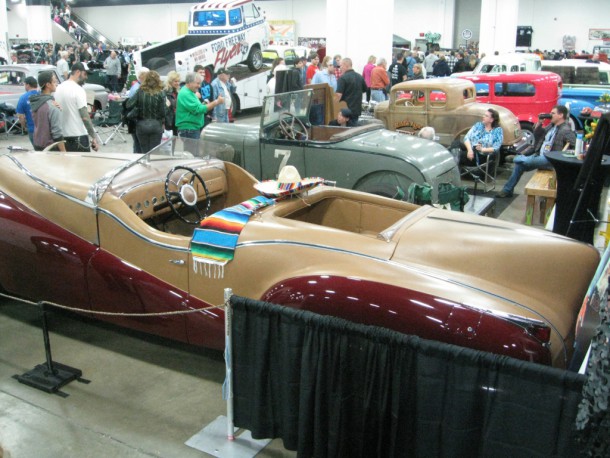
It may be an oddity but it’s a valuable oddity. It’s a genuine, possibly numbers matching Duesenberg chassis underneath the dross. The car has passed through the hands of a number of collectors including, recently, the late Texas lawyer John O’Quinn. He had a fabulous car collection, funded by his billion dollar legal career suing tobacco companies and manufacturers of breast implants. After he died, the estate tried to sell the Duesenberg via Bonham’s in 2011, but it failed to meet its reserve price. The following year it sold for just under $300,000 at a no reserve auction. That seems to me to be about right for a genuine Duesenberg chassis (#J-462) with an ugly body.
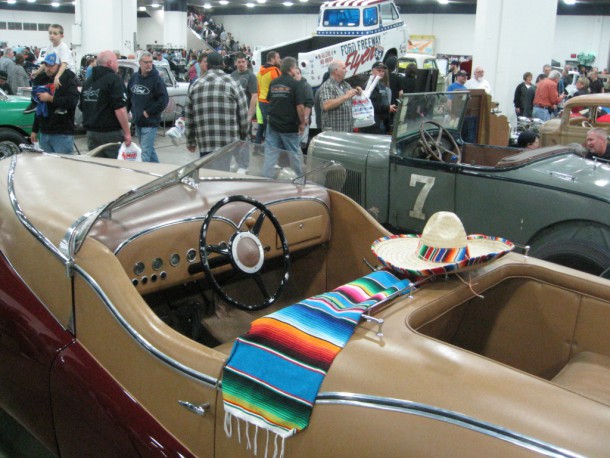
I didn’t get a chance to talk to the owner; a representative was showing the car at the Autorama on the owner’s behalf. I told the rep that I’d written about the car and thanked her for bringing it. I thought it prudent to not mention my opinion on its looks.
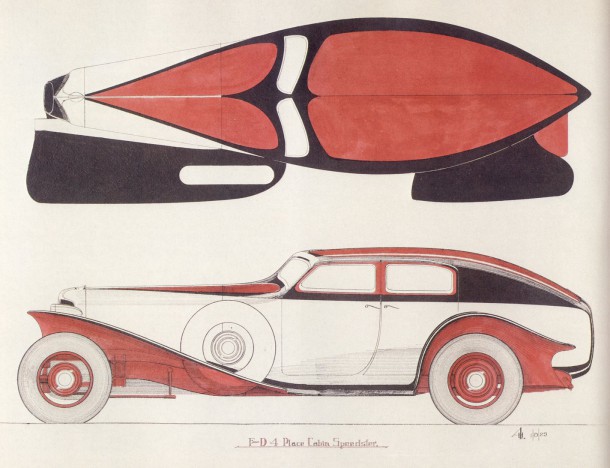
When I last wrote about the “Tom Mix” Duesenberg, I said that if I ever had a large fortune, I’d buy the car, remove the body and put it in a museum to show folks what silly things people did 70 years ago. Then I’d commission Fran Roxas to custom build me one of Alan Leamy’s designs for Duesenberg’s “catalog customs” that never got built back in the day. These days I’m partial to Leamy’s 4 Place Cabin Speedster. Today we’d call it a four door coupe. Roxas — a respected restorer of prewar Packards and Cadillacs and a Pebble Beach concours winner — took a couple of Cadillac V-16 chassis and gave them bodies he picked from the Fleetwood custom catalog that nobody had ordered back in the day. It’s sort of a weird coincidence that the funny looking Duesenberg would show up at the Autorama. I first became aware of Fran Roxas after seeing his Packard Myth coupe at the Autorama.





.gif)


Well-written piece, Ronnie. Gave me a few chuckles as well, particularly, “You can see the full photo gallery here, but why would you?”
Have to agree with all your observations regarding styling, and it’s nice to know that some people would pay $300K for a rolling paean to bad taste. I think it must be the horns that really appeal to the right buyer. The rest is just a showcase carrier for them.
Needs a giant audio system with brass horns continuously playing “Home On The Range” LOUD, if any any observers somehow miss the point.
Forget that, only “Deep in the Heart of Texas” is big and bright enough for that beauty.